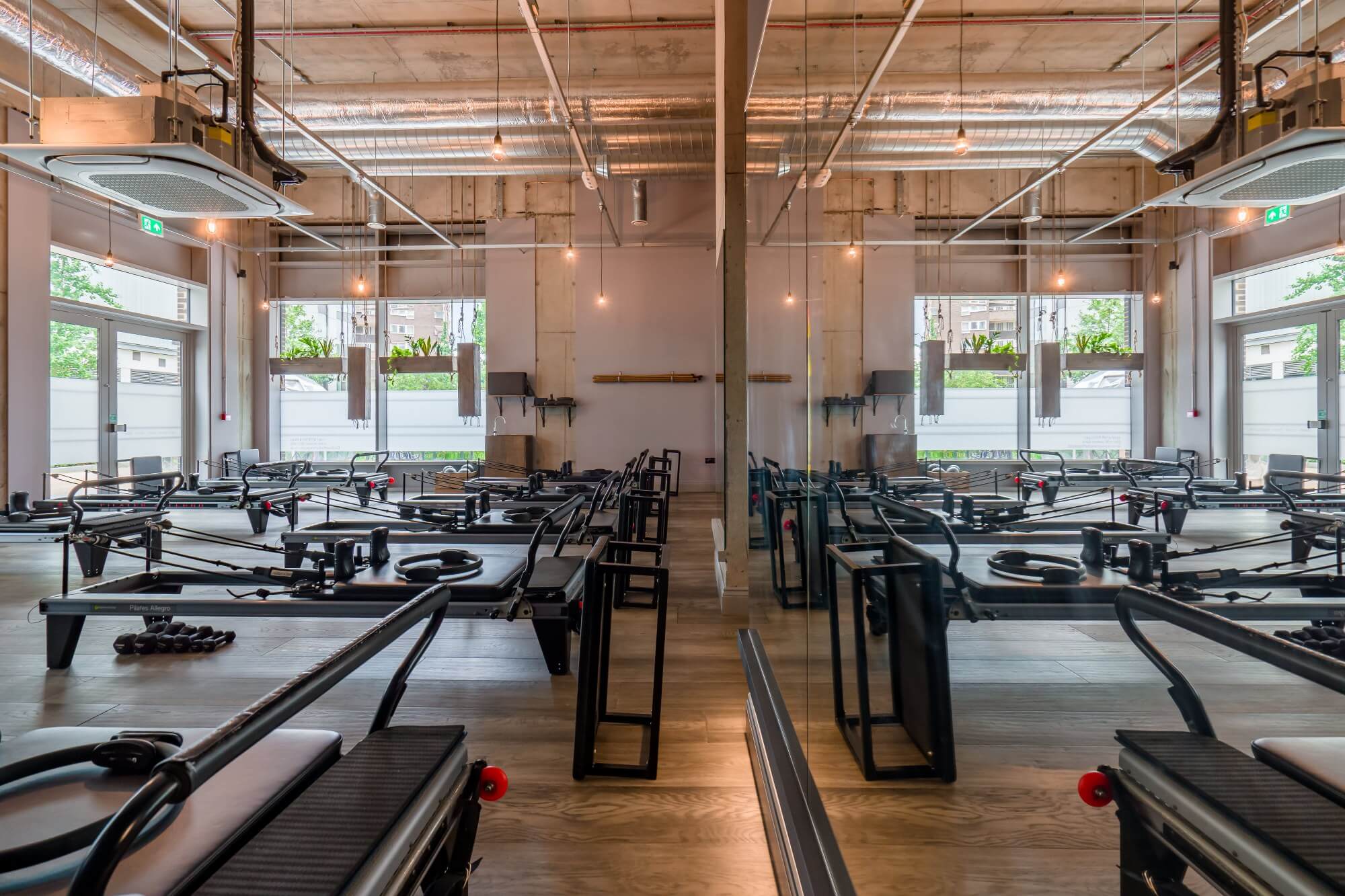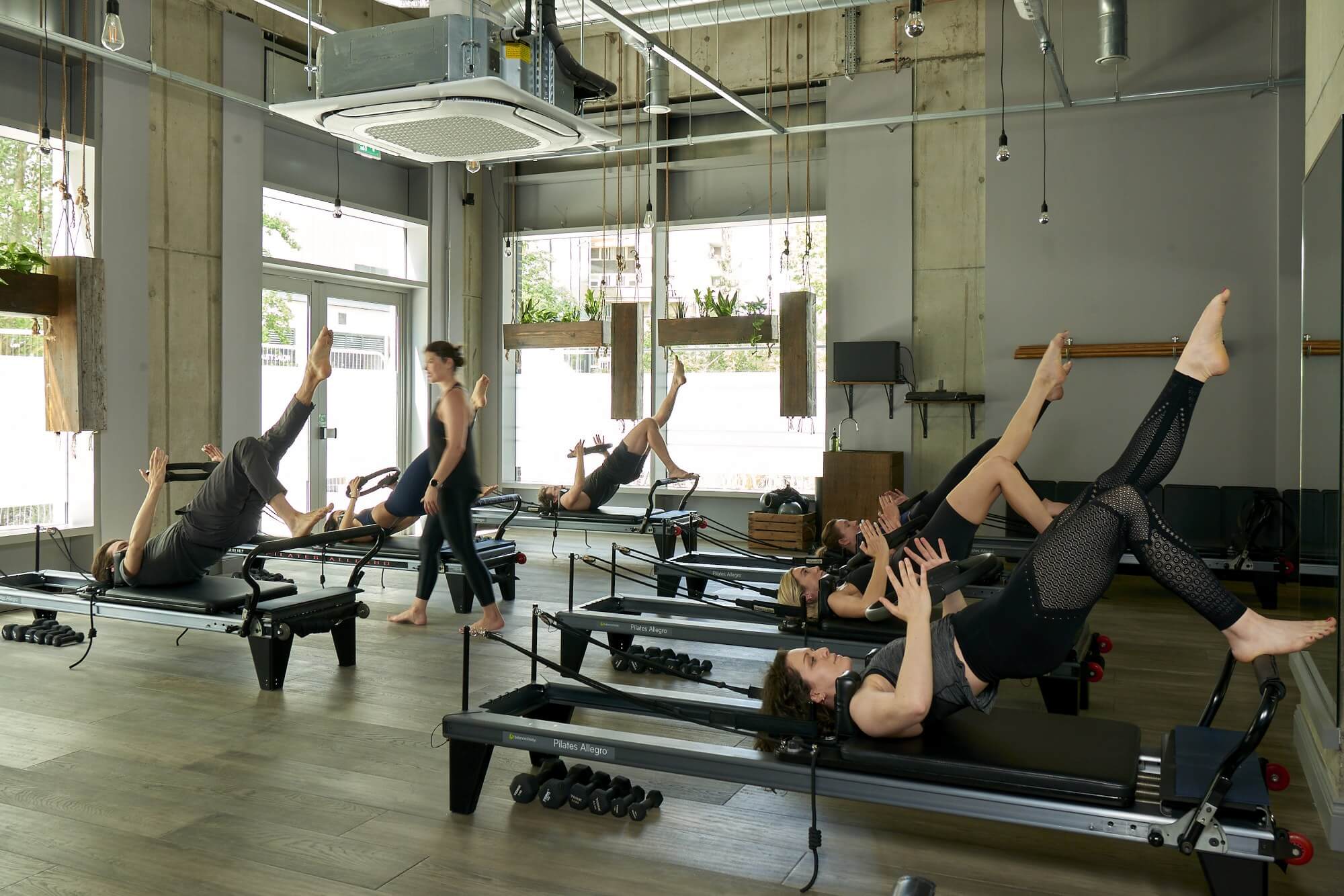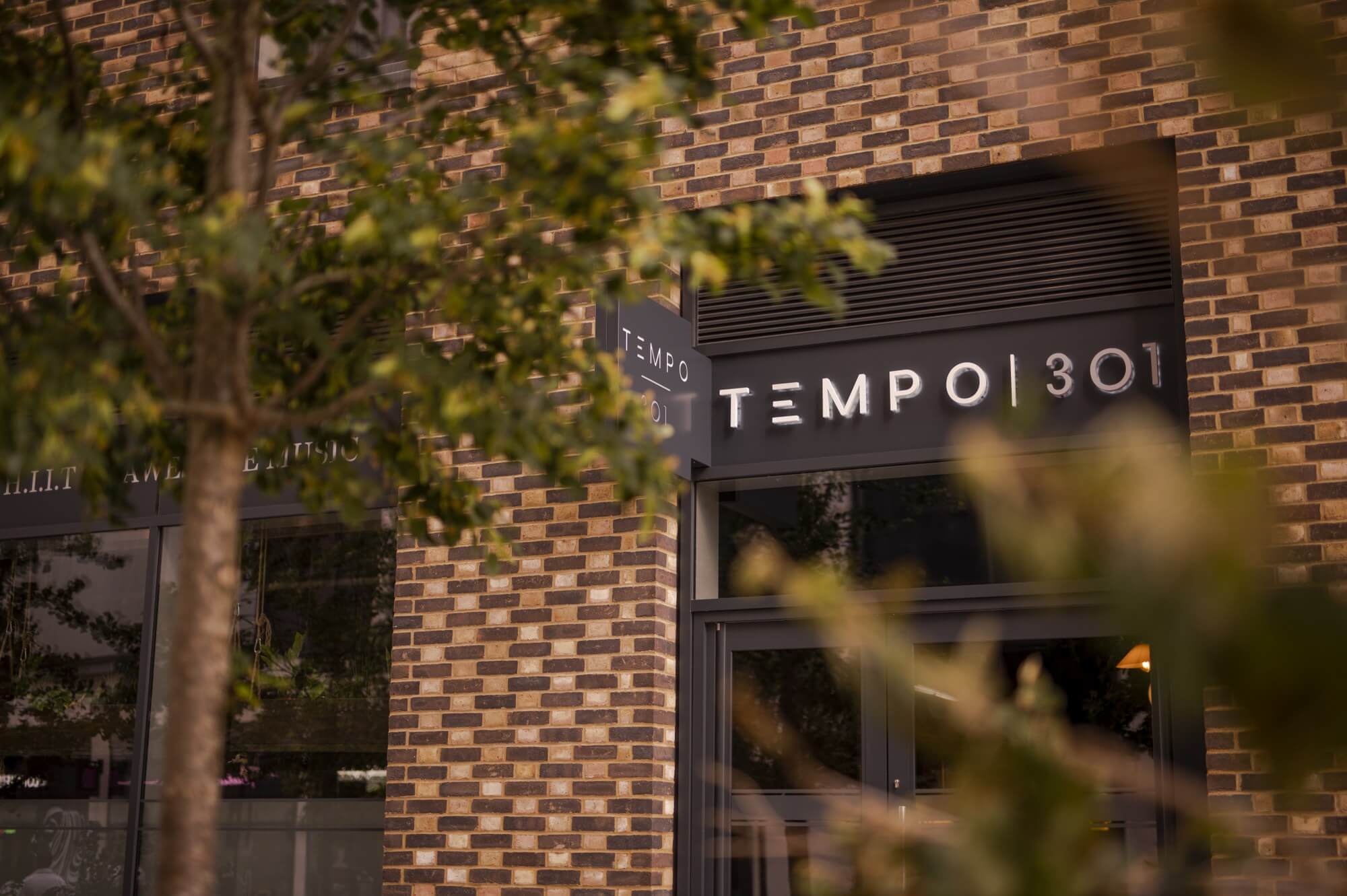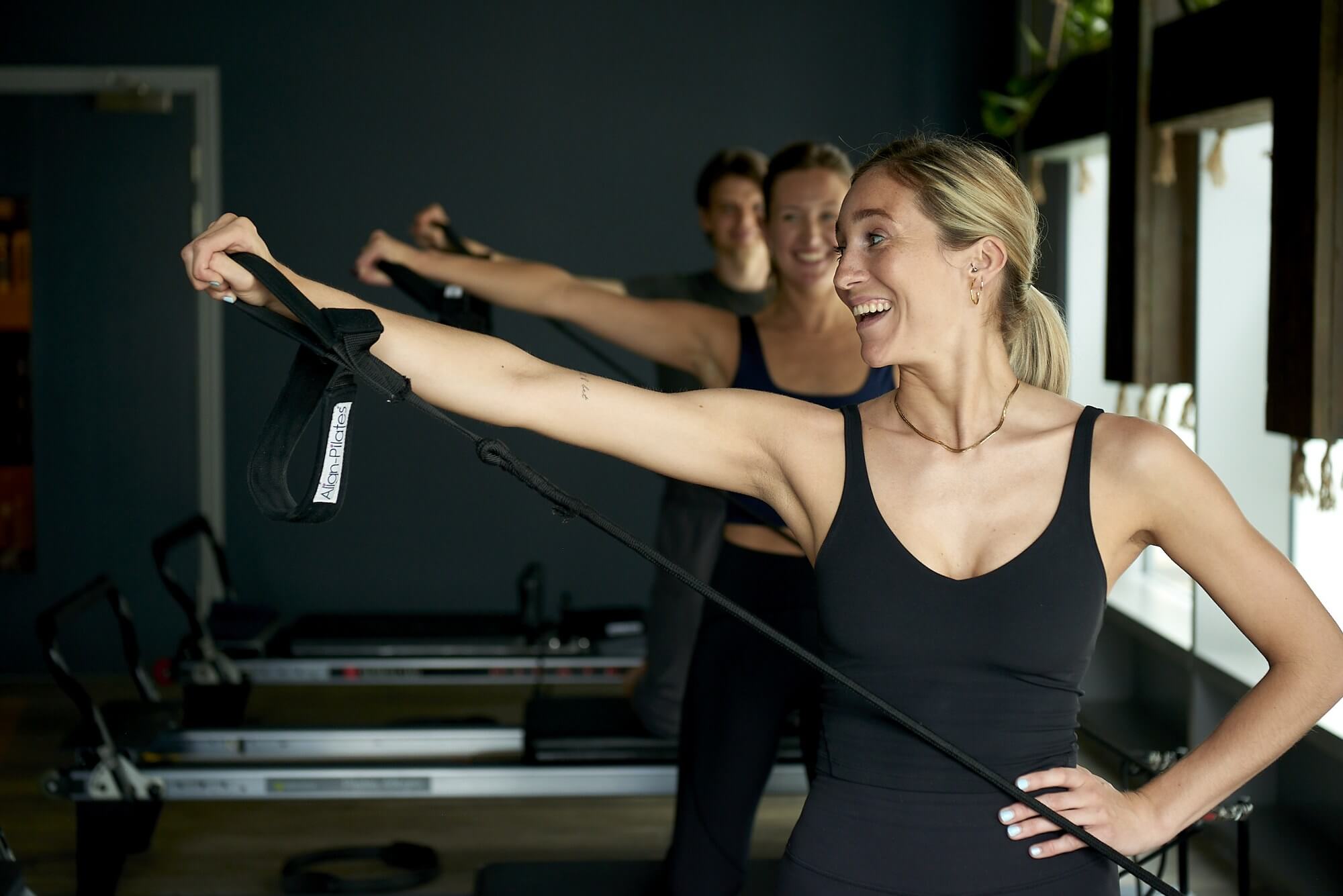Pilates training can sound a bit complicated and unclear of how it can fit into your training program.
But it doesn’t have to be.
People are sometimes so focused on losing weight that they forget to keep up a healthy lifestyle.
We find that oftentimes, those adhering to rigorous workout regimens believe this is the best way to accomplish their goal; however, there are ways to build a strong and healthy body other than running on a treadmill for hours at a time or engaging in high-intensity workouts.
Body alignment, flexibility, and a strong core are equally as important to sustain, especially when in pursuit of a healthy lifestyle.
In this article, you are going to read the term “core” quite often because of how important it is for movement and balance.
Pilates focuses on improving your stability and core strength, both of which are crucial for maintaining a healthy body and way of life.
At Tempo 301, we offer focused, low-impact strength-building exercises like Pilates to tone the body, prevent injury, and maintain mental and physical health.
What is Pilates?
Pilates is a low-impact, full-body workout that centres on engaging your powerhouse and core muscles (i.e. your pelvis, lower back or spine, hips, and stomach muscles).
This workout program will strengthen your muscles, increase flexibility, and infuse fresh life into your daily activities via the combination of precise movements and proper breathing methods.
You may do Pilates with or without equipment.
You won’t feel the same fatigue and elevated heart rate as you do following an aerobic or heavy-weight workout, but you will be surprised to discover how exhausted your muscles can feel after a 45-minute Pilates session when done correctly.
Executing the correct technique is essential when performing movements during a Pilates routine.
Pilates exercises must start with slow, controlled, and precise movements where breathing is controlled.
Indeed, Pilates and core muscles go hand in hand, but Tempo 301’s expert Pilates instructors will lead you through an exercise routine that also activates your limbs and glutes – the perfect recipe to work up a sweat.

The Types of Pilates Training
Joseph Pilates, the creator and promoter of the Pilates exercises, said, “In 10 sessions you’ll feel different, in 20 sessions you’ll notice a difference, and in 30 sessions you’ll have a whole new body.”
Whatever Pilates style appeals most to you, being consistent is essential if you want to see the results of your efforts.
With our signature Tempo Pilates Method added to the mix, there are three forms of Pilates worth highlighting.
Mat Pilates
Mat Pilates originates from the exercises that Joseph Pilates developed to strengthen his body muscles.
This type of Pilates is perfect for any beginner who would like to try Pilates, because there is no need for equipment, apart from a comfortable mat.
Mat Pilates utilises your body weight to conduct the exercise while managing a controlled breathing pattern throughout.
So, whether you are a beginner or have built your skills through a steady increase in difficulty over time, Mat Pilates can be easily modified according to your age, body or fitness level.
This type of exercise is, therefore, perfect for any fitness type and level.
Pro Tip: Concentrate on your movements to execute each slowly and correctly.
With Mat Pilates, quality trumps quantity, so be sure to engage the relevant muscles needed to execute each movement with your body weight for resistance.
Reformer Pilates
In comparison to Mat Pilates, Reformer Pilates can be regarded as a more advanced and versatile method of Pilates.
By strengthening the muscles of the chest, hips, shoulders, and pelvis, this method helps to build a solid core.
And while the reformer machine can be a little daunting to newbies, once mastered, this method can become a game changer for your physical power, strength, and flexibility.
For a brief explanation, the bed-like frame and soft platform of the reformer machine (also known as the carriage) rolls back and forth with the aid of wheels as you exercise.
And with a set of springs that connects the carriage to one end of the reformer, you can exercise at varied levels of resistance and intensity.
Because of this ingenious design, you have various options for exercises that you can use the machine for.
Exercises can be performed in many different ways using the reformer machine – lying down, seated, sideways, or upright – giving you an even better chance to engage in exercises that complement your current fitness level.
Whether you are a beginner, a master, or even a recovering athlete, this method can be perfectly tailored for you.
Pro Tip: Reformer Pilates works your arms and legs in addition to your core, unlike Mat Pilates, which focuses on the core primarily.
Additionally, this technique ensures that the muscles cooperate and work together rather than only focusing on one part at a time!
Also Read – High Intensity Interval Training – Everything You Need to Know
Tempo Pilates Method
Tempo Pilates is a comprehensive Reformer Pilates method executed in conjunction with curated music, carefully selected with the perfect tempo, to feature all the benefits of classic Pilates principles.
We add the 301 Tempo philosophy to a series of controlled and precise mind-body movements, each guided by regulated breathing.
Our classes are designed to be performed at a tempo that encourages flow while promoting centring and concentration.
This method is excellent for boosting energy, increasing lean muscular tone, and building strength.
It is a fresh and upbeat approach to Studio Pilates that provides both challenges and enjoyment.
Deviating ever so slightly away from traditional Pilates workouts, our classes will boost your heart rate through higher intensity and increased resistance.
With the Tempo Pilates Method, you can burn more calories, enjoy a full-body workout, build lean muscle, and sculpt and tone your body all in one session.
Our dedicated trainers strive to motivate you to achieve more than you ever imagined.
Through personalised adjustments, Tempo 301 will advance your Pilates practice and make you feel your best.
We are here to change the way you think about exercise, to turn that dreaded hour of the day into an exhilarating experience.
Come work out with us the Tempo Pilates way!
Tempo Pilates classes are currently hosted in London Hackney | E8, Shoreditch | E1 and Elephant Park | SE17.

The Benefits of Pilates
Any type of exercise is beneficial for your health, but using the right approach can maximise the effects.
Pilates uses a comprehensive approach, emphasising both physical and mental wellness.
Here are a few brief explanations for why you should enrol in your first Pilates class right now.
– Core Strength
True to its meaning, our core or “powerhouse” is a group of muscles that forms the centre of your body’s ‘existence’ – or in this case, your body’s balance and stability.
Your core is responsible for the movement of the spine and trunk.
It stabilises your body through controlled movement and distributes weight across your body, relieving your spine from carrying the weight on its own.
Pilates strengthens your core muscles, increasing your body’s stability and flexibility, and decreasing the probability of experiencing lower back pain and hip discomfort.
– Improved Posture
Something as simple as incorrect body posture is oftentimes the origin of headaches and many injuries, especially those prone to lower back and spine injuries.
Teaching yourself to consciously be aware of sitting straight behind your desk should become a daily habit to ensure good body alignment.
In doing so, your back receives the much-required support from the surrounding muscles.
Pilates can help you with this as it allows you to breathe slowly while becoming more aware of your body posture.
– Injury Prevention
The best method for preventing injuries is Pilates.
Not only will your muscles refrain from getting overly stiff and rigid with this method of exercise, but they will also become strong and supple (this will help reduce the further chance of injuries).
Joint injuries are common among athletes, but Pilates can help build up the muscles that protect your ligaments and joints from harm.
– Increase Energy
Whether to think clearly or to improve digestion, there is magic behind breathing correctly, especially when taking in those deep breaths.
Pilates exercises include proper breathing; this will increase your energy levels and allow you to sleep better, thus leading to an improved immune response.
Deep breathing enables your lungs to take in more oxygen-rich air, which in turn transfers oxygen-rich blood to your body and results in a more energised “you” after a workout.
– Relieve Stress
During a Pilates class, maintaining excellent posture and practising effective breathing techniques are the ideal ingredients for de-stressing.
Stress stops your immune system from functioning at its peak, which makes unpleasant health conditions like the flu or sinusitis more likely.
Through deep, regulated breathing and an inward emphasis on excellent body awareness, Pilates reduces stress chemicals (such as cortisol) and increases your “feel-good” hormones (such as endorphins).
Pilates Training Tips for Beginners & Experienced
The notion that Pilates movements demand more expertise than a simple jog is true, but once you have mastered Pilates, the advantages will quickly transfer to your strength and endurance training, not to mention your daily life.
Here are our Top 10 Pilates tips, for beginners and experienced fitness lovers, to keep in mind when entering a Pilates studio, regardless of whether you are a Pilates master on the reformer machine or this is your first week attending a session:
1. Think Positively
This tip should be applied to all aspects of life: by eradicating negative self-talk, thinking positively lowers stress.
Allow yourself to go through difficult times, but try not to spend too much time kicking yourself down.
Maintaining a happy attitude helps you cope better throughout the day, not just while you exercise.
2. Be Patient
This follows from our initial piece of advice.
Be cautious when expecting quick results.
Determine your current level of fitness, then gradually increase it.
Patience is a virtue, as the saying goes.
No one ever claimed it would be simple, but the rewards come from all the patience and hard work you put in.
3. Focus On Quality
Pilates requires you to maintain attention on each movement, in contrast to Yoga where your mind might wander into a contemplative state.
Therefore, you must take your time with each movement.
Pilates, as previously stated, is all about quality above quantity.
These sessions are just as successful as their technique, not how quickly you work.
4. Listen To Your Body
Any fitness program may experience resistance at first, which can demotivate you.
Do not be discouraged.
Your body grows more acclimatised to the movements as you work out, and as a result, your muscular strength and flexibility improve.
Be sure to comprehend your body’s limitations and avoid pushing yourself too far since this might result in avoidable injuries.
5. Focus On Your Breathing
Every effective Pilates exercise centres on controlled breathing.
Puffing or wheezing will not get you very far in a Pilates studio, so pay attention to your trainer’s instructions and inhale and exhale carefully for the best results.
Also Read – Cross-Training – How to Fit Pilates & HIIT Into Your Training Regimen
6. Stick To A Schedule
Find a regimen that works with both your personal and work schedules.
Pilates should be enjoyable and leave you feeling energised.
Start with a routine that is scheduled and appropriate for your fitness level, and increase your speed gradually as you get stronger between exercises each week.
7. Stay Hydrated
We tend to only grab our water bottles when we are thirsty – that means you are already too late!
Keep water with you at all times when practising Pilates; staying hydrated only requires taking a few sips during breaks.
Despite the slow, steady motions of Pilates, you will perspire throughout the workout.
8. Carefully Select Your Music
During Pilates, pay close attention to your breathing, body posture, and proper core muscle activation.
You could become distracted and lose concentration if you choose the wrong music, so be sure to listen to something that will keep you motivated.
Our Tempo Pilates Method has you covered!
9. Stretch Before & After
This should not come as a surprise, especially because stretching is crucial to ensuring that your muscles and joints function as efficiently as possible before and after any workout.
Stretching primes your muscles for the task at hand and subsequently relaxes the tense ones.
It’s a win-win.
10. Find A Good Pilates Instructor
A minimum of 4-6 months of theoretical and practical training are required to become a certified Pilates instructor, and because it requires skills, Pilates is not an activity that just anybody can teach.
Investigate or research the trainers that you sign up with before enrolling.
Our Tempo Pilates trainers are well-skilled and have experience in abundance – in fact, before they begin teaching at our studios, each of our trainers must complete another 6 weeks of training in addition to their prior expertise.
Dedication at its finest!

Our Final Thoughts
Since its creation and refinement in the 1920s, Pilates has been used as an effective method to strengthen the muscles in the core, and relieve stress in the shoulders, back (particularly the lower back), and legs.
Whether you would like to enhance your posture or utilise it as a stress reliever, Reformer Pilates offers many advantages to establishing a better lifestyle.
Every fitness level that enters our studios can benefit from our Reformer Pilates classes since they are tried and true.
At Tempo 301, our knowledgeable Pilates instructors will ensure that you enter each Pilates session enthusiastically and that you can leave classes feeling energised and anticipating the next.
Book your first Beginner or L1 class with us today and experience the change!
For more information, please feel free to contact us or visit one of our studios:
LONDON SE17 | Elephant Park
Call/Text: 07881 746 243
LONDON E8 | Hackney
Call/Text 07563 578 165
LONDON E1 | Shoreditch
Call/Text 07798 586 925

